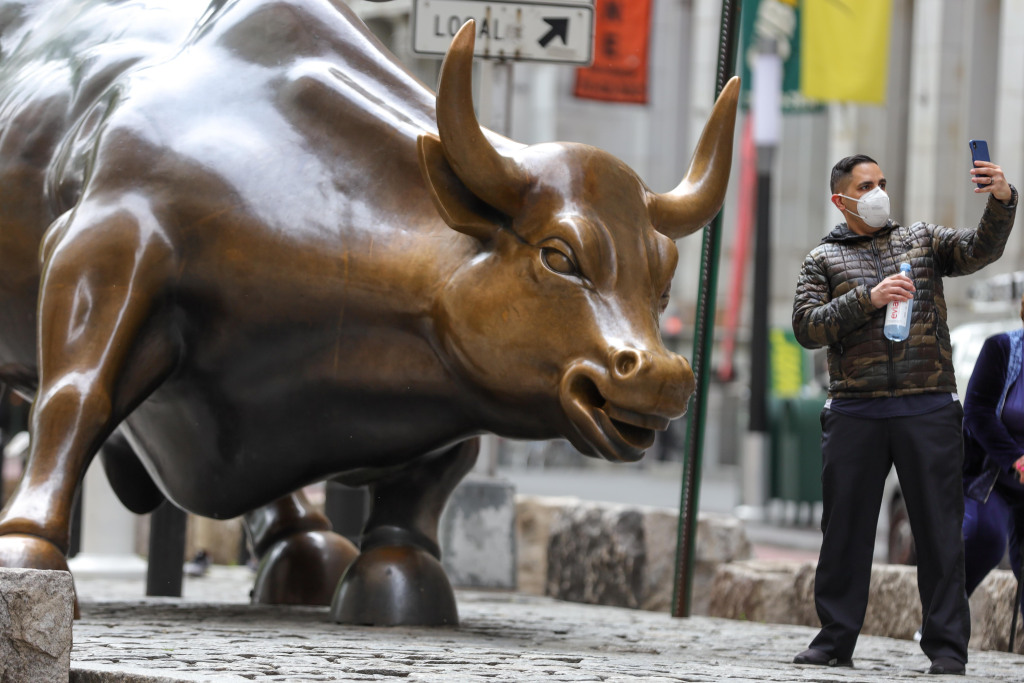[ad_1]
Faced with a volatile stock market and plummeting economic prospects owing to the coronavirus pandemic, Wall Street could use a mascot to burnish its once bullish reputation. But a planned symbol of the sort is not coming anytime soon, after a meeting that was supposed to launch a privately financed initiative to relocate Charging Bull—a famous 1989 sculpture by artist Arturo Di Modica—a few blocks from its current site in Lower Manhattan to the steps of the New York Stock Exchange imploded on Tuesday evening. In a tense standoff, city officials and local residents called the proposal “bizarre,” “outrageous,” and “potentially illegal.”
The video conference ended with Community Board 1, which oversees the Financial District and other parts of Lower Manhattan, sending the city back to the drawing board in a near-unanimous downvote, along with a request for alternative proposals that would keep the bronze bull at or near its current location. The vote marked a loss for mayor Bill de Blasio’s administration, which has been trying to move the sculpture for six months. But the arguments presented for moving Charging Bull have also laid the groundwork for future challenges to the artist’s ownership of the popular monument.
A symbol of the rising market, the artist initially deposited Charging Bull in front of the New York Stock Exchange in 1989. It was quickly impounded by the city but later installed two blocks south of its original site at Bowling Green. The sculpture remains an anomaly in the city’s collection of nearly 800 artworks. Unlike other monuments and memorials, the city has no contract or formal agreement granting it ownership of Charging Bull; the bronze has never gone through the Public Design Commission’s approval process for permanent works as required by the City Charter; and the city neither implements nor funds repairs on the statue. In fact, New York’s recent decision to move the 31-year-old statue came last September after a man attacked the bull with an imitation metal banjo, leaving the beast with a gash under its right horn. Di Modica returned to New York from Sicily to administer the repairs himself.
But now, the city is claiming that the bull’s relocation is necessary to prevent future violent acts and possible terror attacks. Opponents of the relocation plan have dismissed such concerns, claiming that the iconic bull would become an even stronger draw for violence if placed directly next to the New York Stock Exchange—which plans to finance the move—in an area normally congested with thousands of tourists. City representatives also failed to demonstrate that anyone has ever been personally injured at the statue’s current location, despite millions of tourists congregating around the bull each year.
“I don’t have to be a security expert to know that the New York Stock Exchange is surrounded with barriers because of terrorist attacks. There could not be a worse place to put Charging Bull,” said Arthur Piccolo, president of the Bowling Green Association and a representative for the artist, during the community board meeting.
“No great city in the world would eliminate or alter one of its most successful symbols,” said art historian Todd Fine during his testimony. “This would probably become a big disaster scandal for the city, another farce in the middle of a pandemic, and an embarrassment to the mayor.”
Another rebuttal came from Laura Starr, who served as the Central Park Conservancy’s chief landscape architect in the 1990s. “I work on Broad Street. It’s a complete no man’s land. Total chaos,” she said. “I think the bull belongs where it is, with its leafy background behind it.”
Despite resistance from local leaders and art historians, the city has neither admitted defeat nor conceded that it lacks authority over the bull. “City law established procedures wherein city agencies can apply to the Public Design Commission in order to relocate pieces of art on property that the agency controls,” explained Edward Pincar, the Department of Transportation’s Manhattan borough commissioner. “We have worked closely with the administration and the law department to ensure that this is within our rights to do, and we believe it is.”
Until the meeting, public officials had declined requests to release details of their proposal. But yesterday’s presentation included renderings of Charging Bull on a corner of Broad Street just a couple feet away from a fire hydrant and down the road from the Fearless Girl statue. Officials were also unclear if the bull should face north or south, offering versions where the statue directly faced the New York Stock Exchange, or turned its backside toward the building. And several residents of a nearby building argued that this consolidation of public artworks would clog the narrow streets with tourists, leaving Exchange Place—a road used for trash pickup—as their only escape from the crowds.
“This is going to destroy our quality of life,” said one resident. “Our property values are going to tank because of the bull.”
“The fact that you don’t know which way to face the bull shows there is no context. It’s really ugly,” said Starr, who served as Central Park Conservancy’s chief landscape architecture in the 1990s. “I think the bull belongs where it is with its leafy background.”
And there is little reason to expect that Di Modica will allow the bull’s move without a fight. The proximity between Fearless Girl and Charging Bull has already been a source of legal conflict. In 2017, Di Modica’s lawyers accused the investment firm behind the aforementioned bronze of violating the artist’s copyright, which resulted in her own relocation from Bowling Green to the New York Stock Exchange.
“There is no such legal right to move the artwork,” added Piccolo, the artist’s surrogate at the meeting. “The city does not own Charging Bull.”
[ad_2]
Source link

